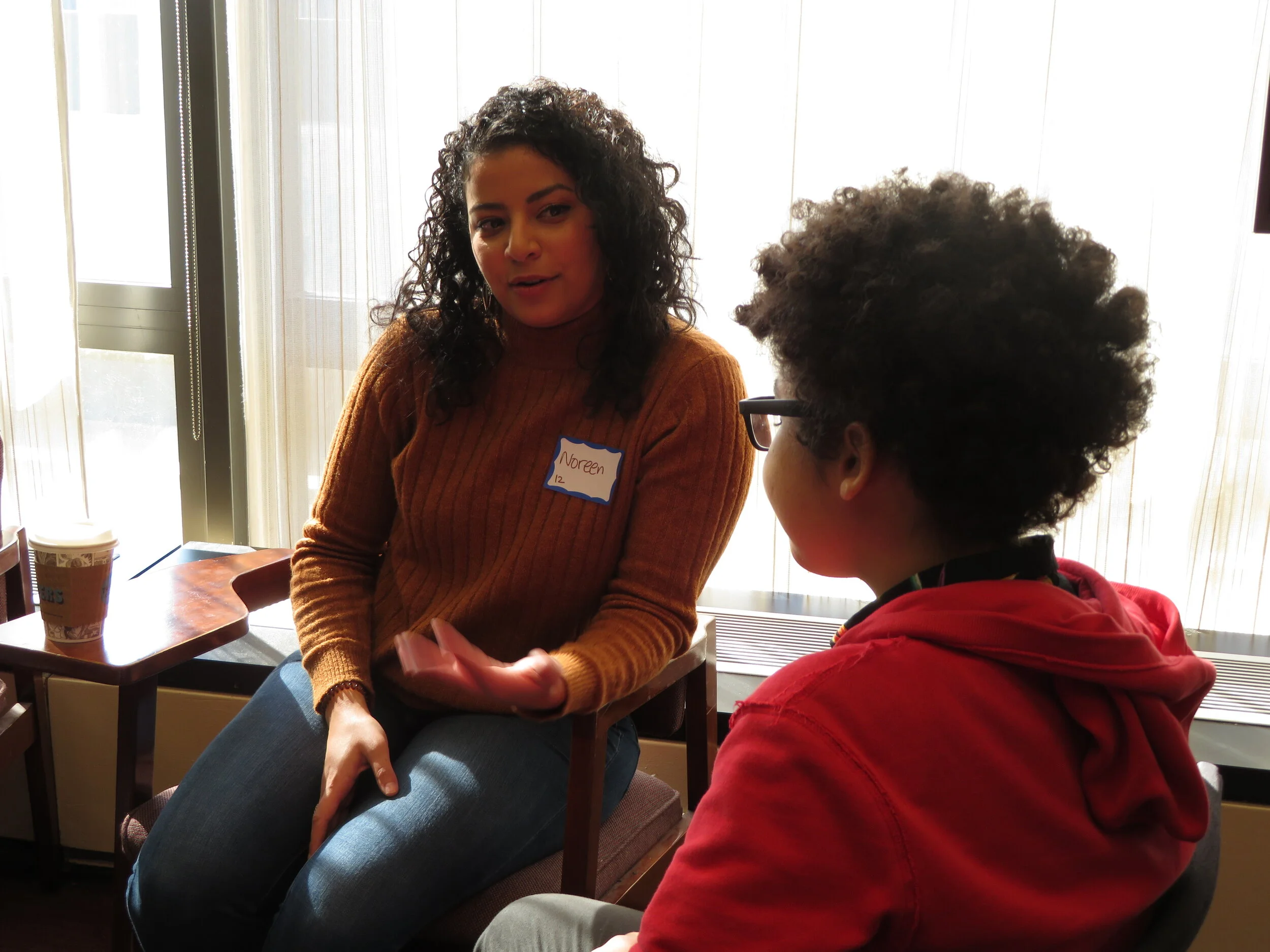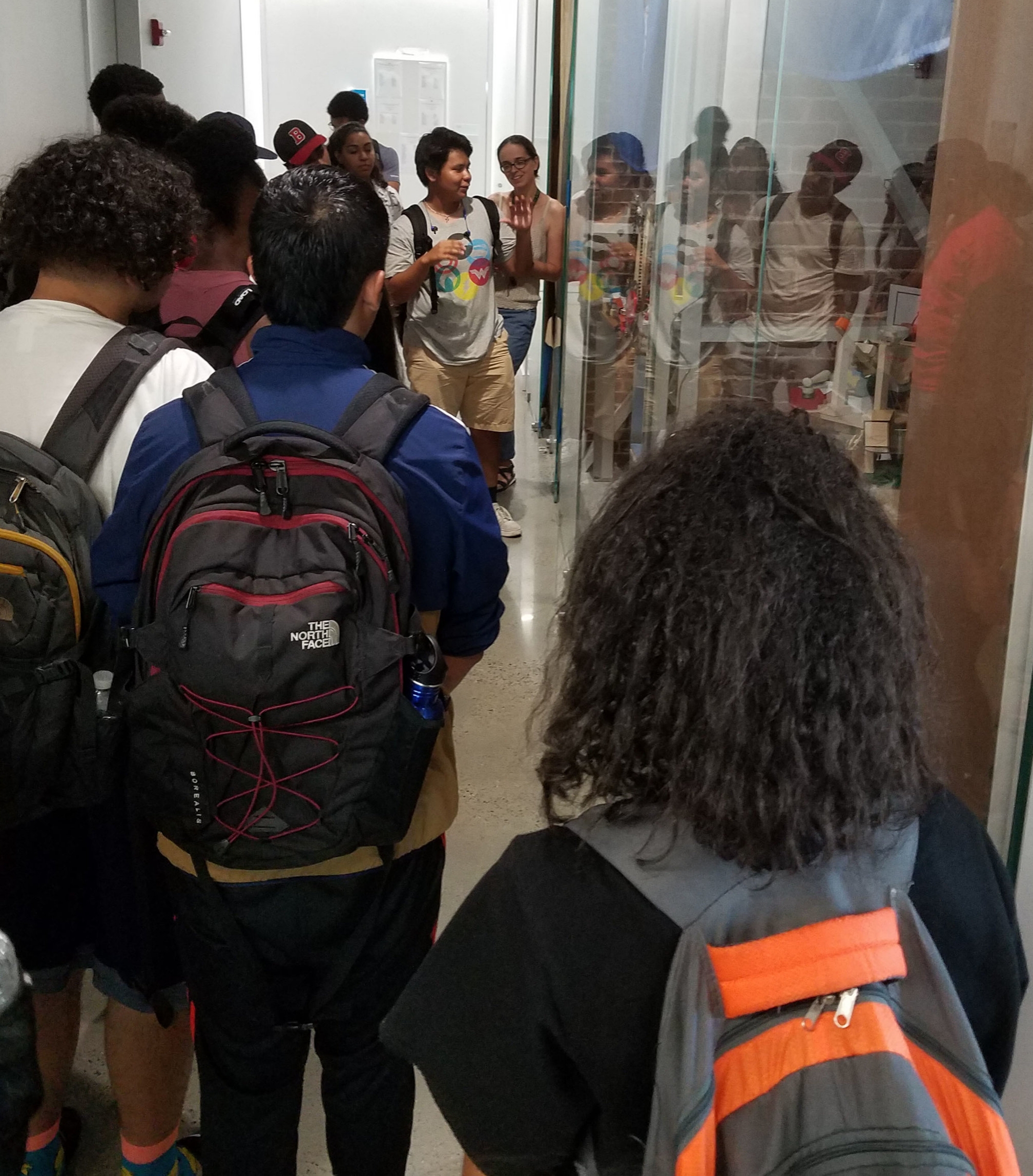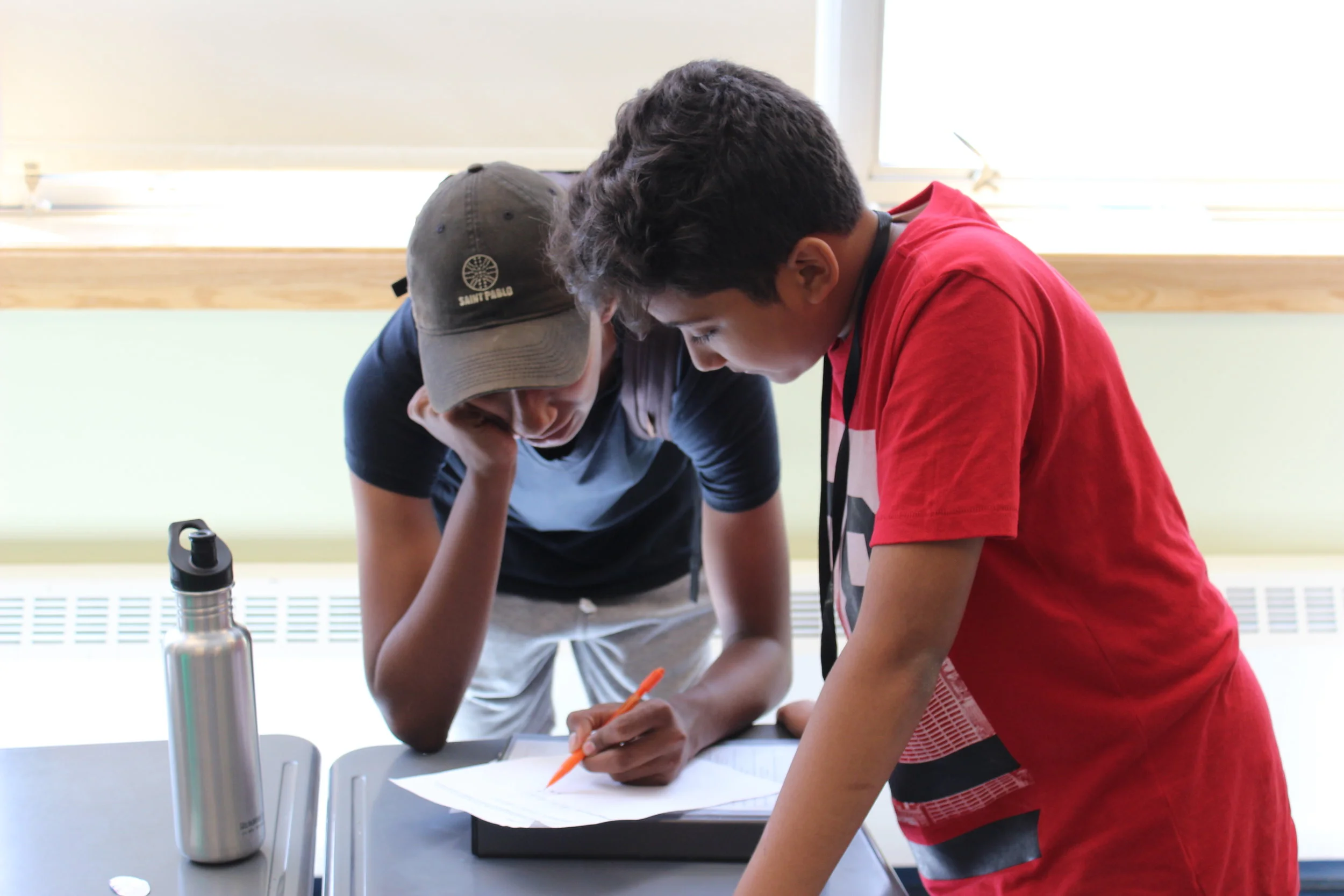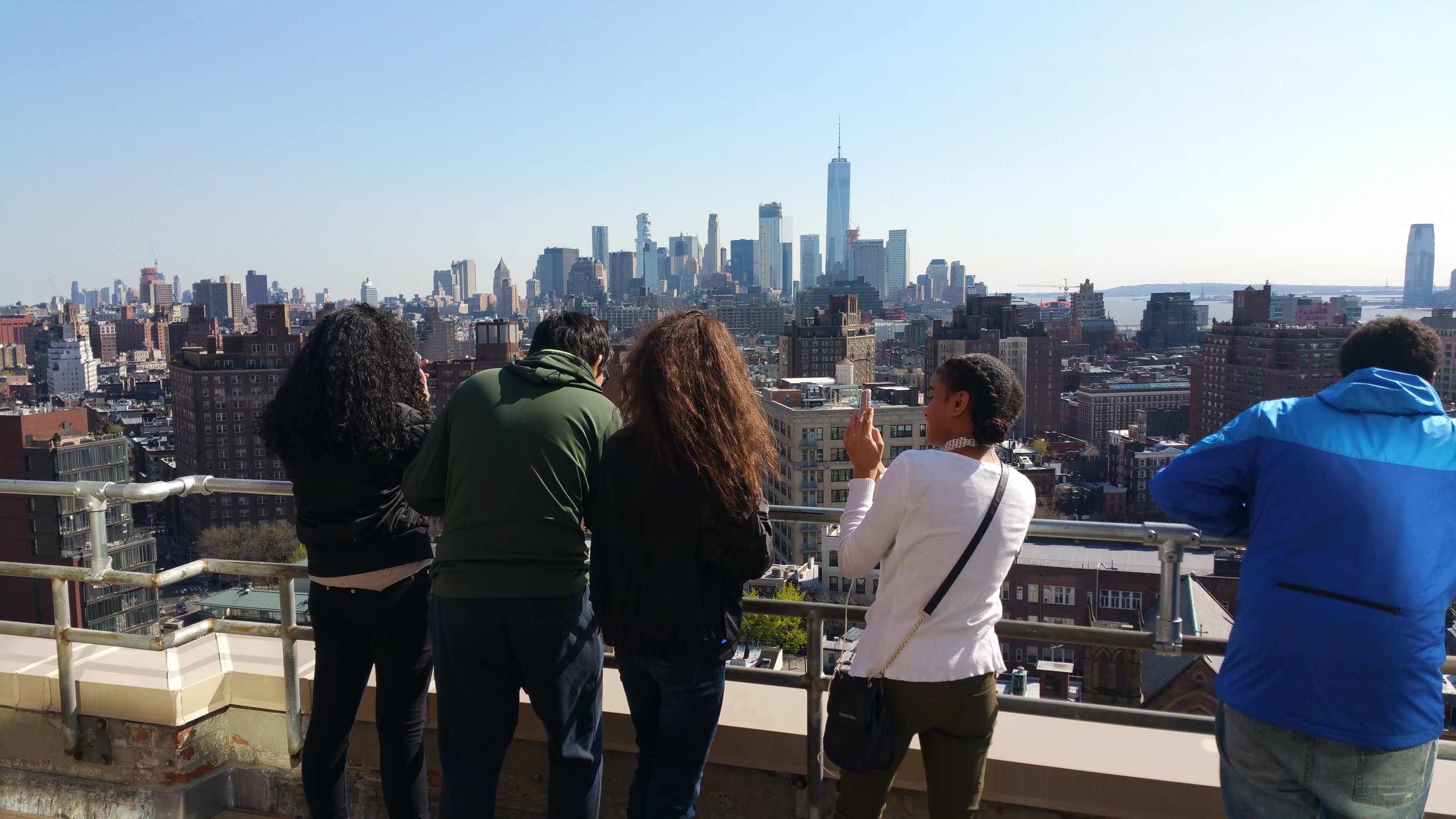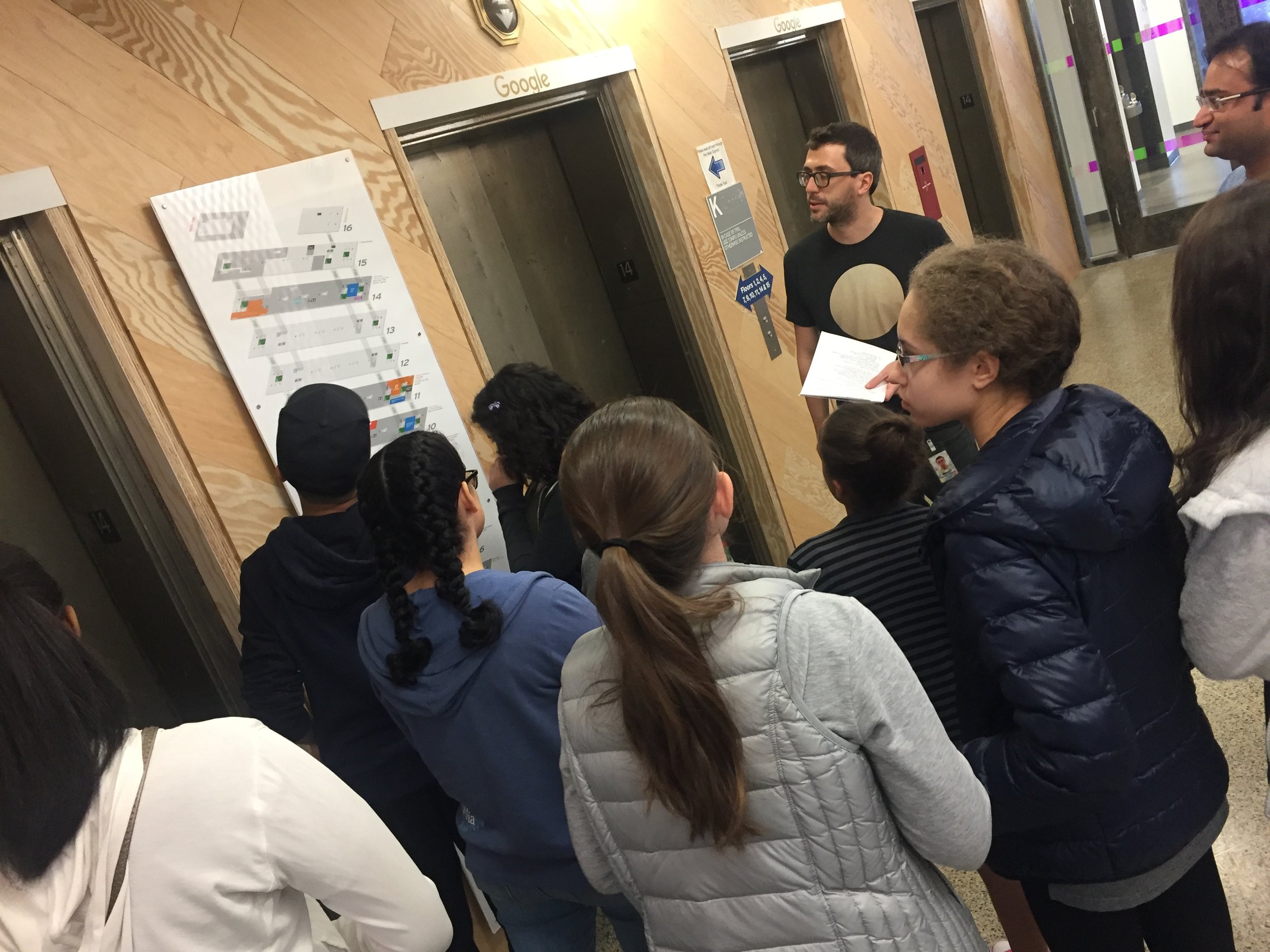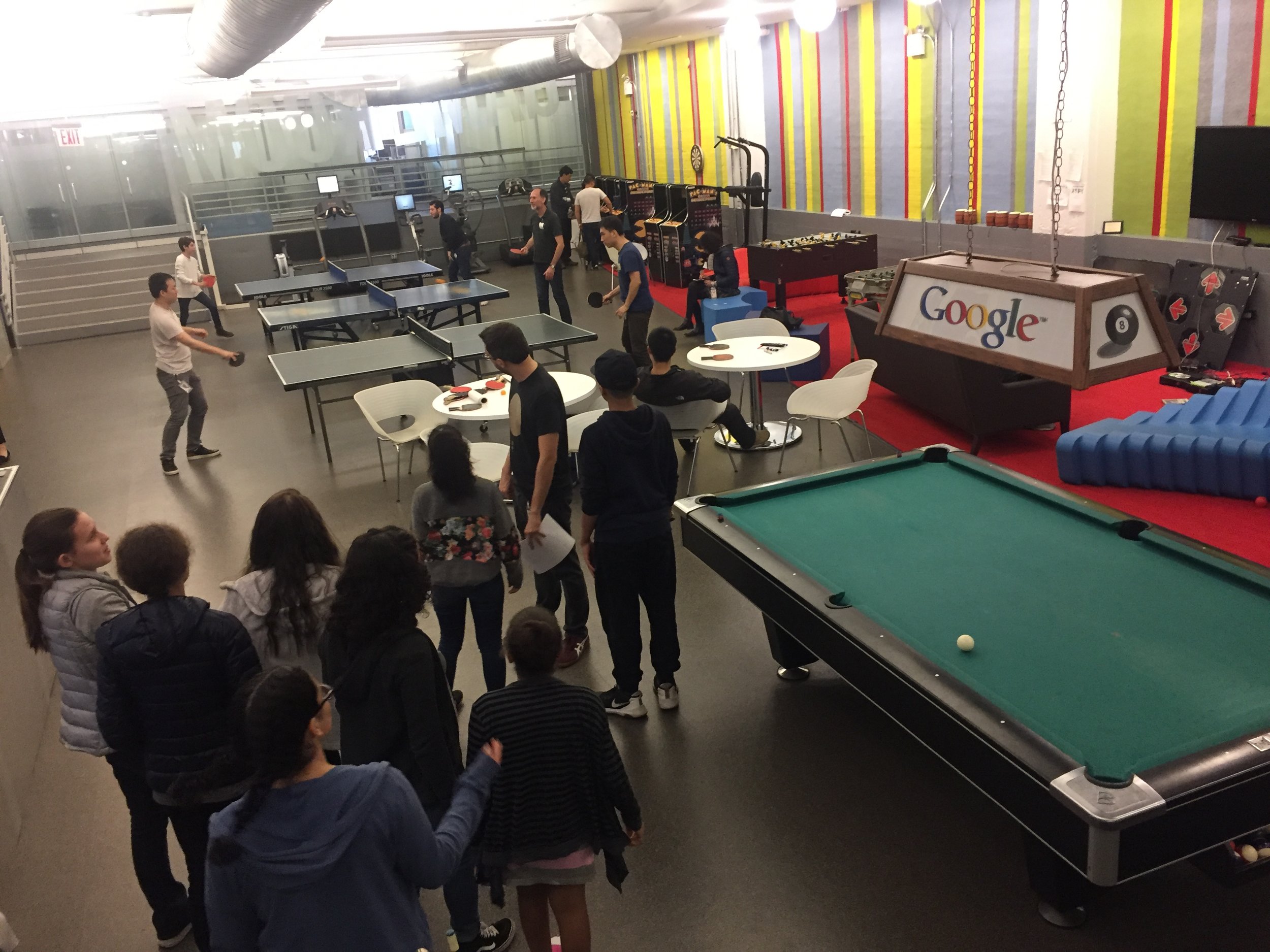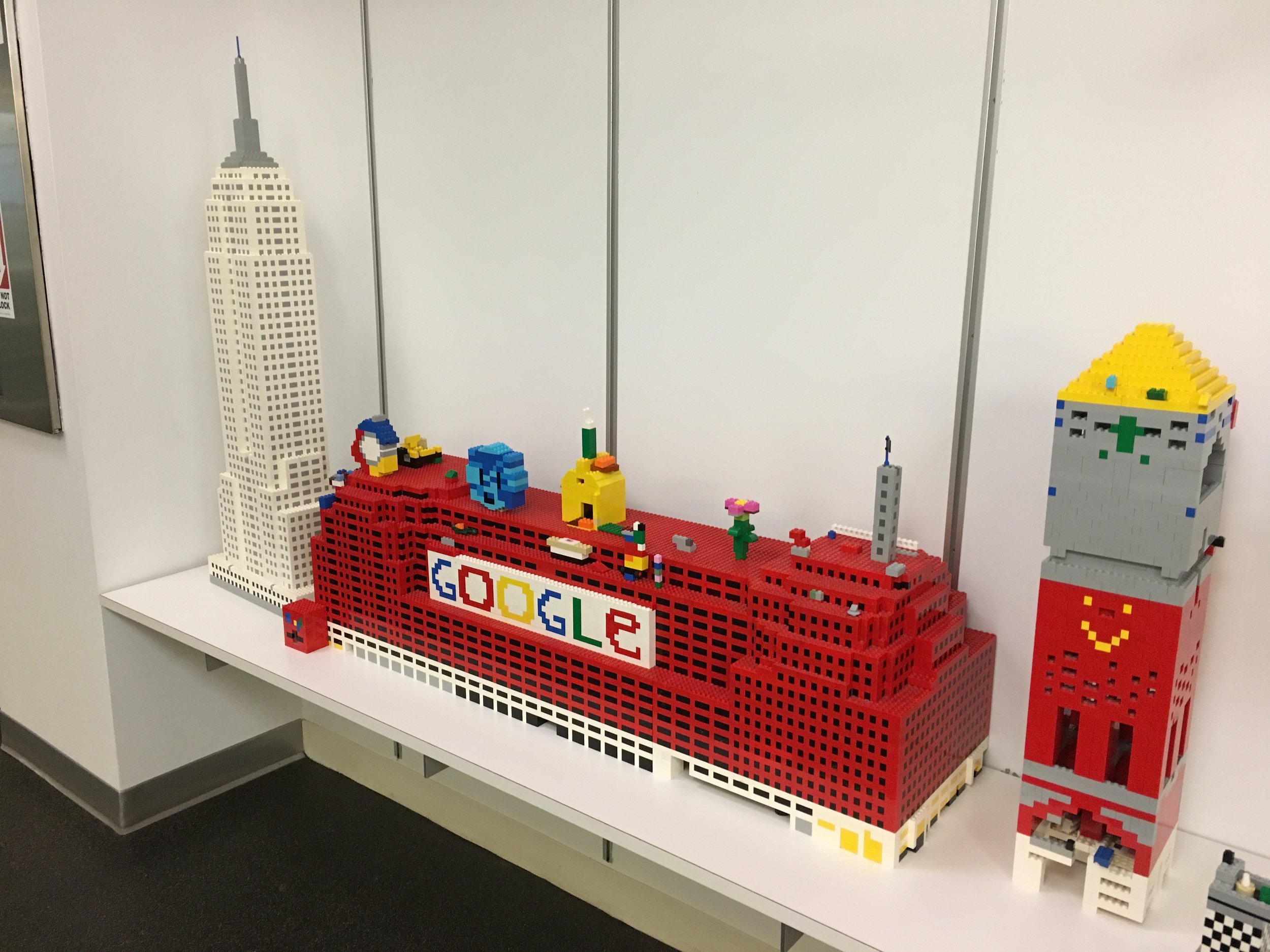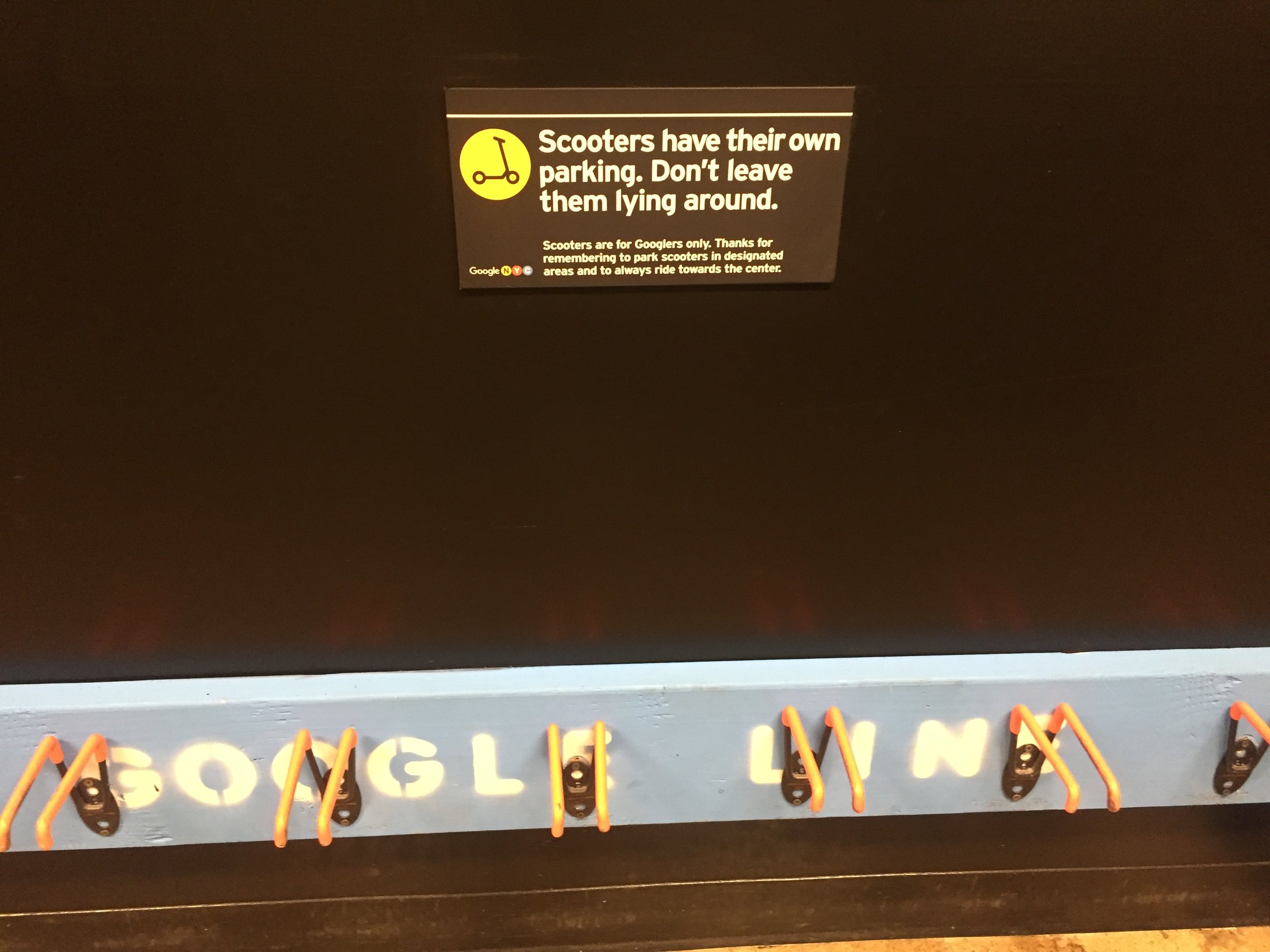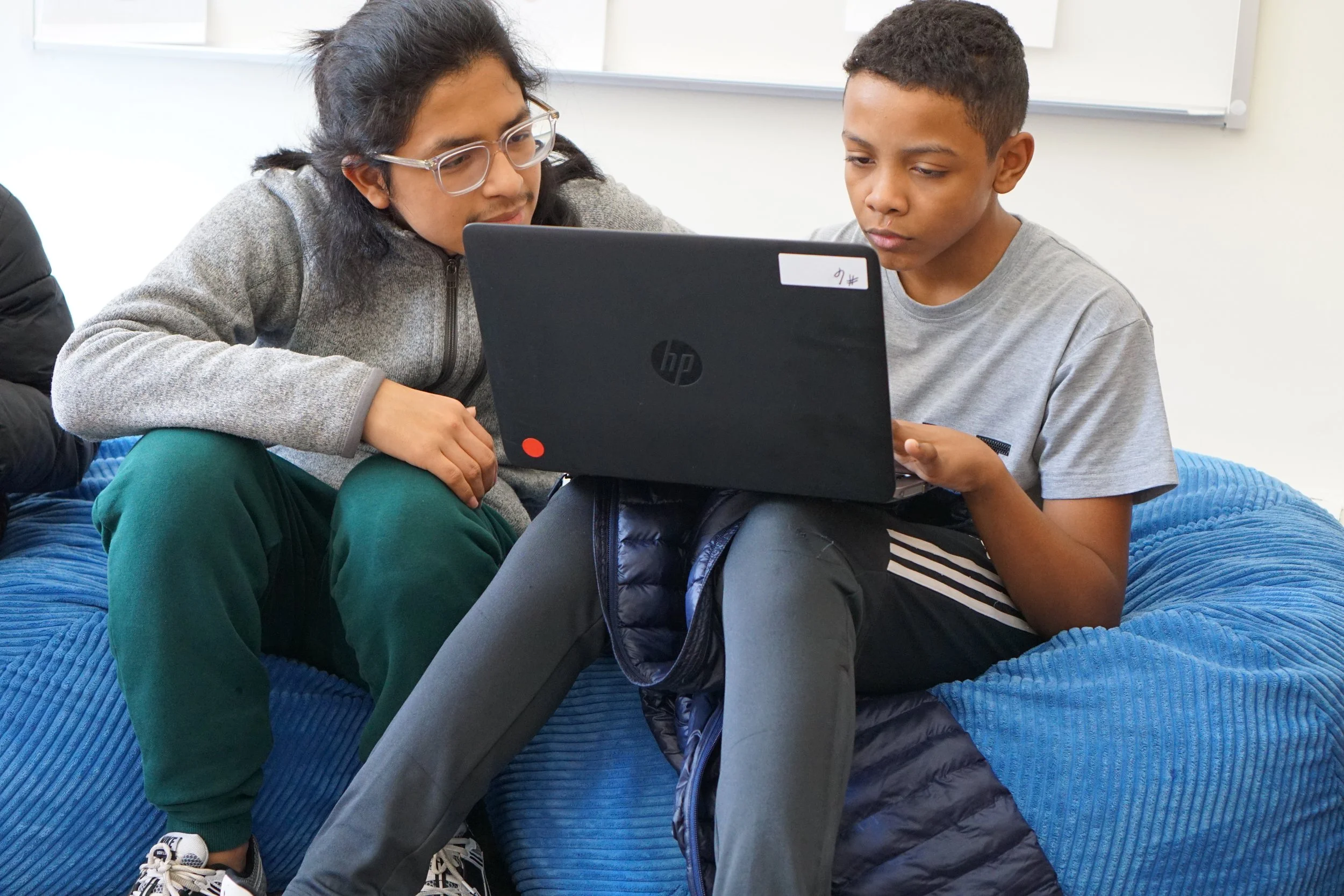
Welcome to the BEAM Blog!
BEAM Career Day
What does it take to fall in love with what you do?
Choose a job you love, and you will never have to work a day in your life.
On Saturday, November 2, more than 60 BEAM high schoolers streamed into NYU’s Courant Institute for BEAM’s 2nd Annual Career Day. Students met professionals from education, law, medicine, sales, engineering, counseling, veterinary sciences, entrepreneurship, and more!
To keep things interactive, during the morning session, small groups of students rotated among speakers, who talked about their professional journeys and answered questions. Afterwards, students spent lunch networking: getting to know folks they hadn’t already met and asking more questions. Students left inspired — with business cards, LinkedIn accounts, and opportunities for future engagement!
Darryl is an algebra teacher at a charter school in Brooklyn. This summer he taught voting theory at BEAM Discovery’s downtown site.
Darryl Gladstone, a math educator in Brooklyn, said about his experience: “Career Day was wonderful and cathartic. The students were thoughtful and inquisitive about what I do and above all were sponges ready to soak up new information. It was also great to network with other professionals in different fields — ones who share the same passion for enlightening the future generation.”
Our professionals had words of wisdom for our students. They spoke about their journeys from middle school through college. Many talked about how they navigated being the “only one” in spaces. They discussed hardships they faced, and ultimately inspired our students to be their best selves.
“Any chance you get to meet people, go out and meet [them] and ask them hard questions.”
Rudy is the Director of Entrepreneurship and Gaming Programs at The DreamYard Project.
“You don’t need to know what you want to do now. People are still figuring it out. Being here today shows you’re already exploring options; that’s really great.”
Noreen works in advertising for Microsoft and is also a content creator and influencer.
“With careers, we sometimes think we need to choose one direction or another. That’s not true; for example, you can code AND write - that career exists.”
Erin is a Client Success Manager for Jopwell, a career development platform for Black, Latinx, and indigenous students and professionals.
BEAM students asked thoughtful questions to get to the crux of what passion is and why it’s so important to be in a career that you love. Some have already been reaching out to folks they met asking for guidance and potential future opportunities for internships and enrichment!
Kathy (above, right) is a 9th grader at The Brooklyn Latin School.
“I know what I want to do but I don’t know HOW to do what I want to do.”
Isabella is a senior at Manhattan Center for Science and Math and a Posse finalist!
“I was wondering, how did you develop the ideas to innovate the gaming field? Also, did it come from an entrepreneurship viewpoint? I am looking to major in engineering in college and I find many of these careers inspiring.”
Want to find out more about Career Day and the professionals who participated? Click below.

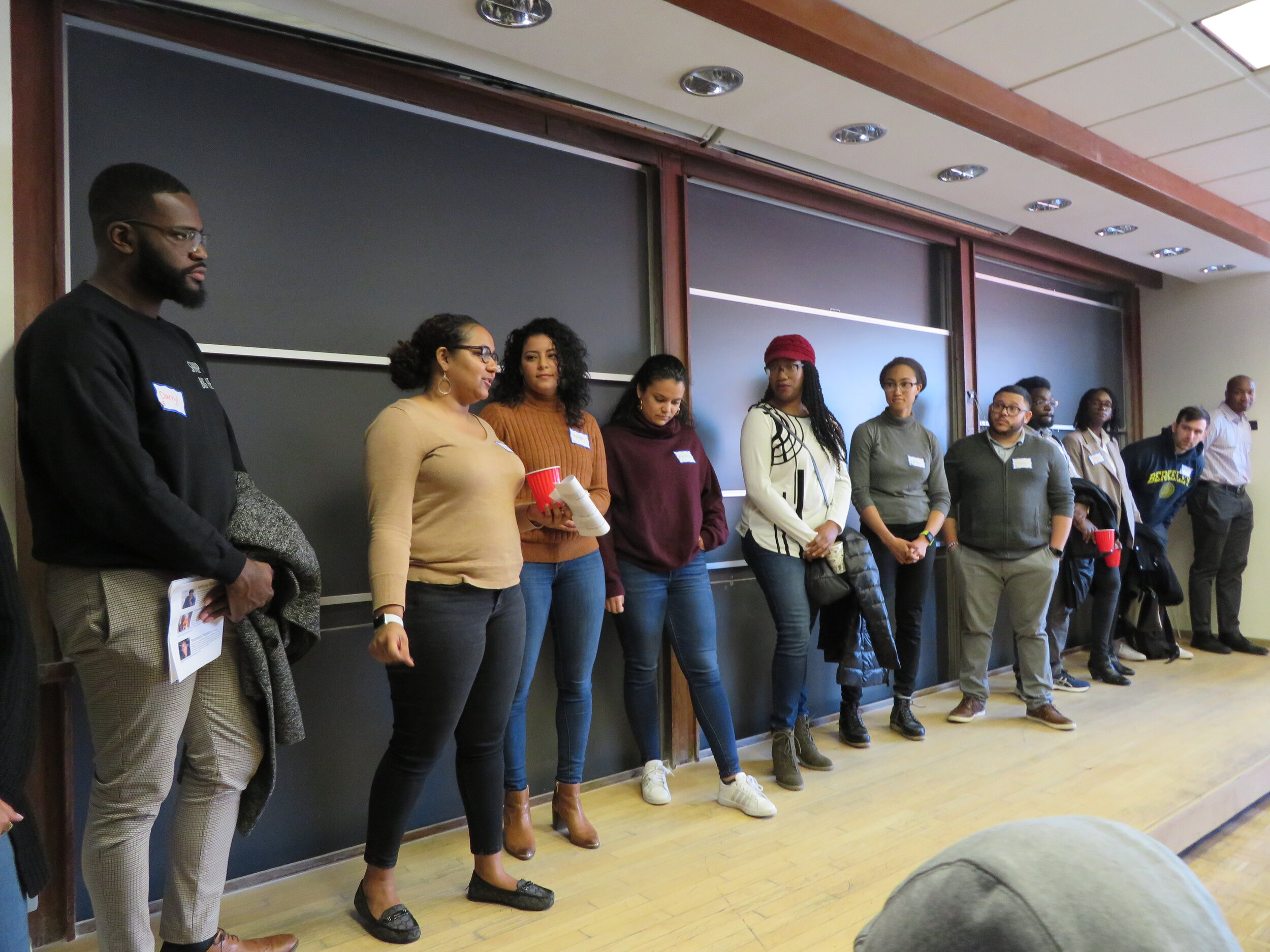
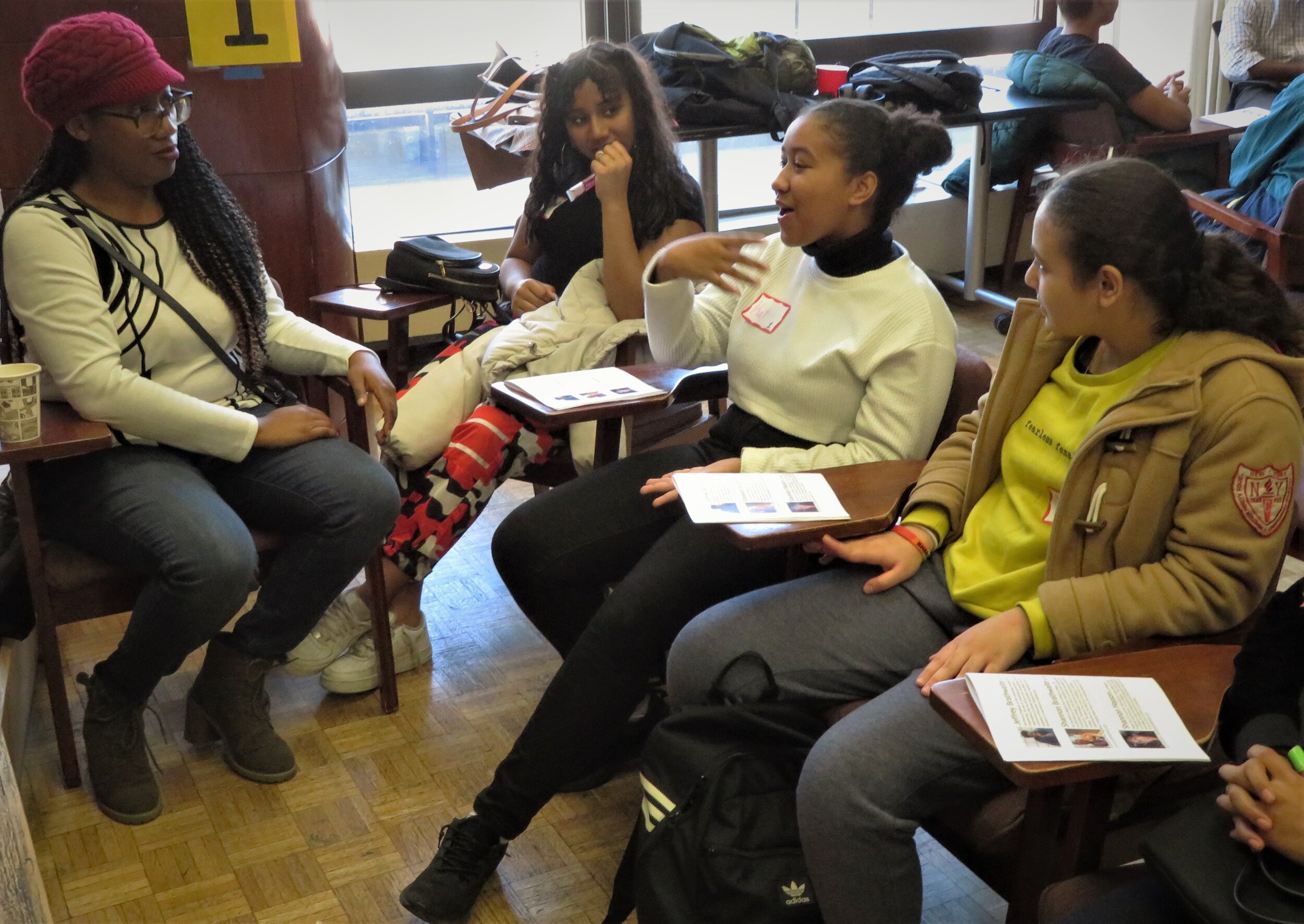
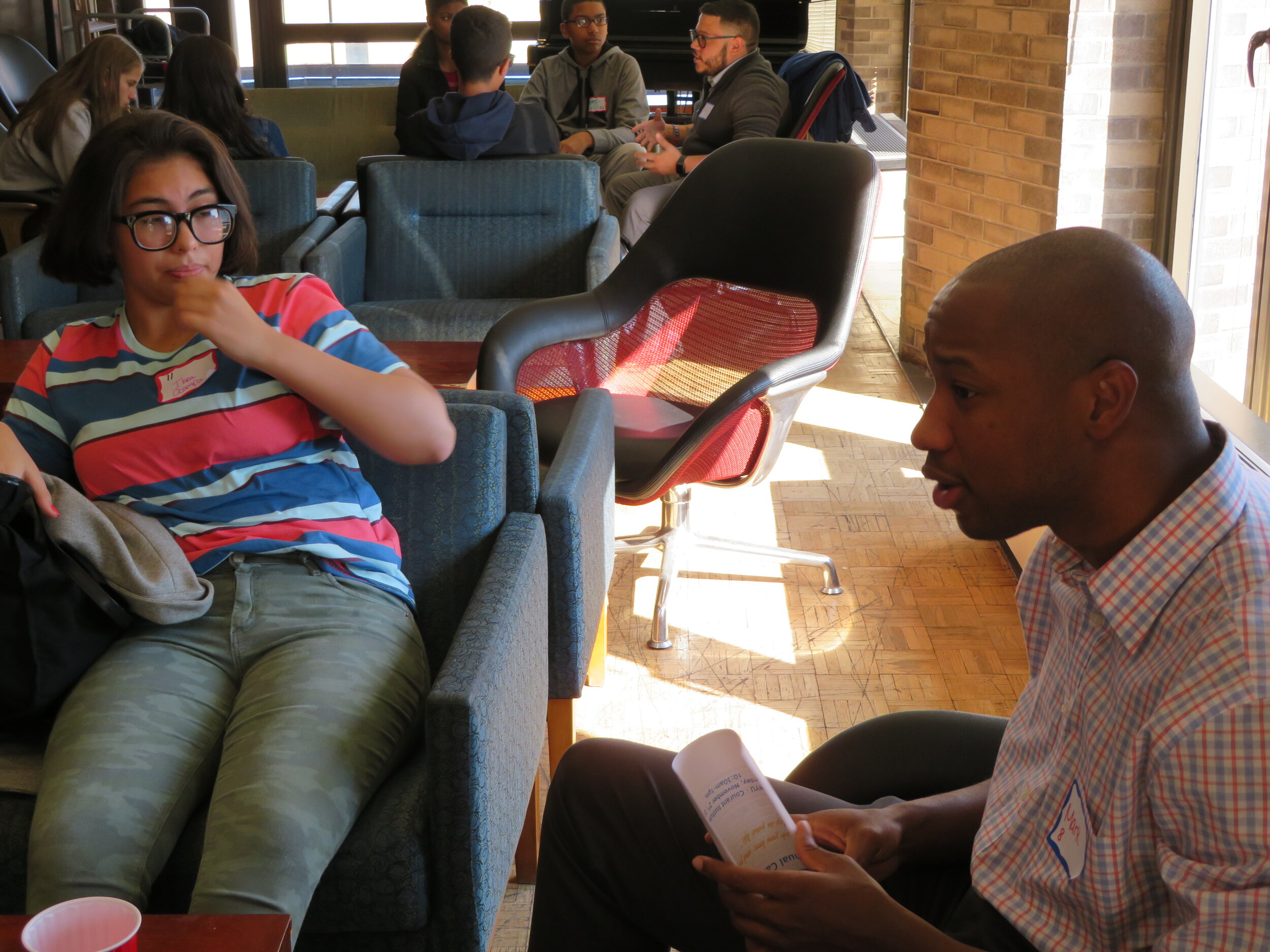
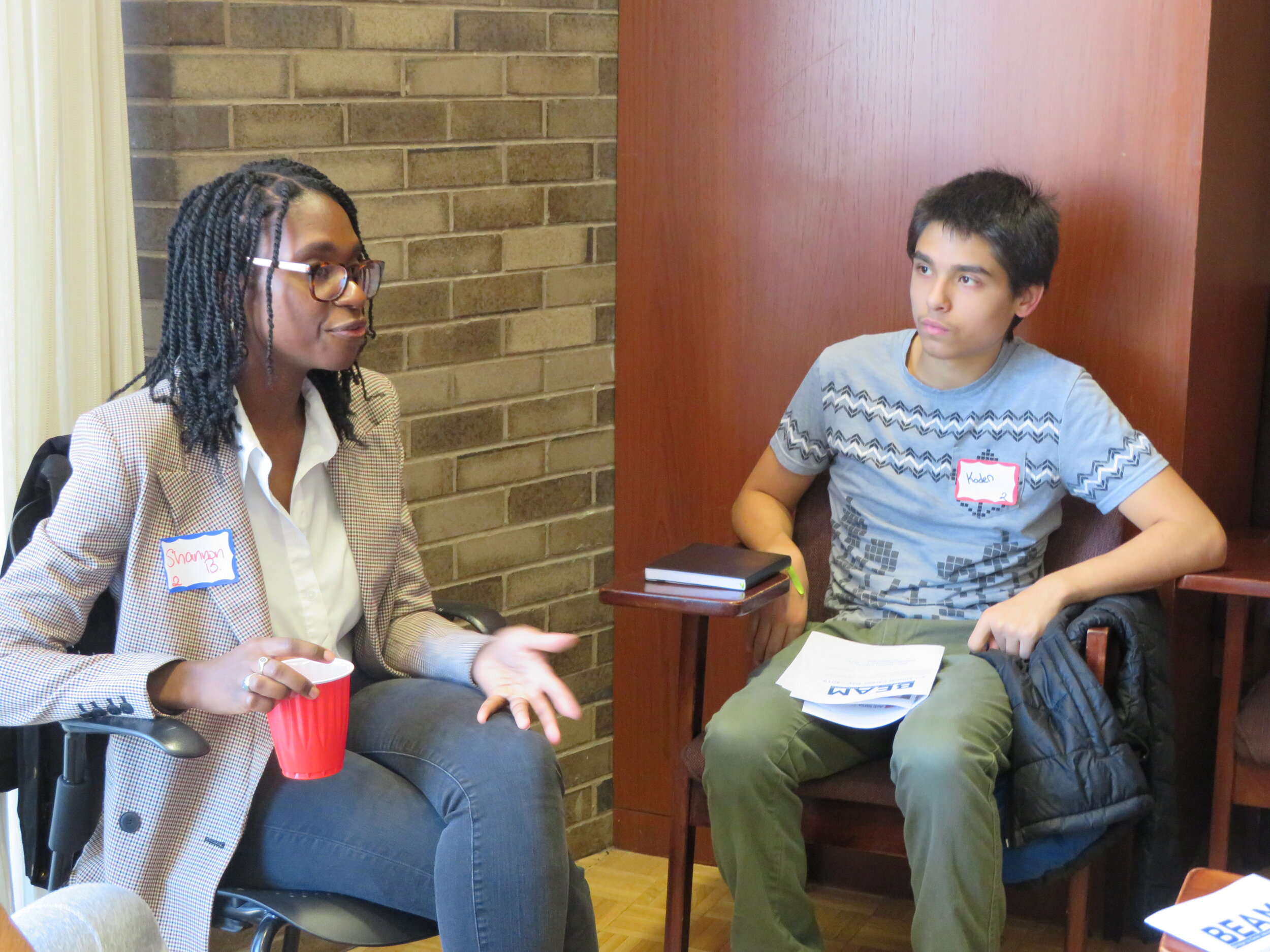
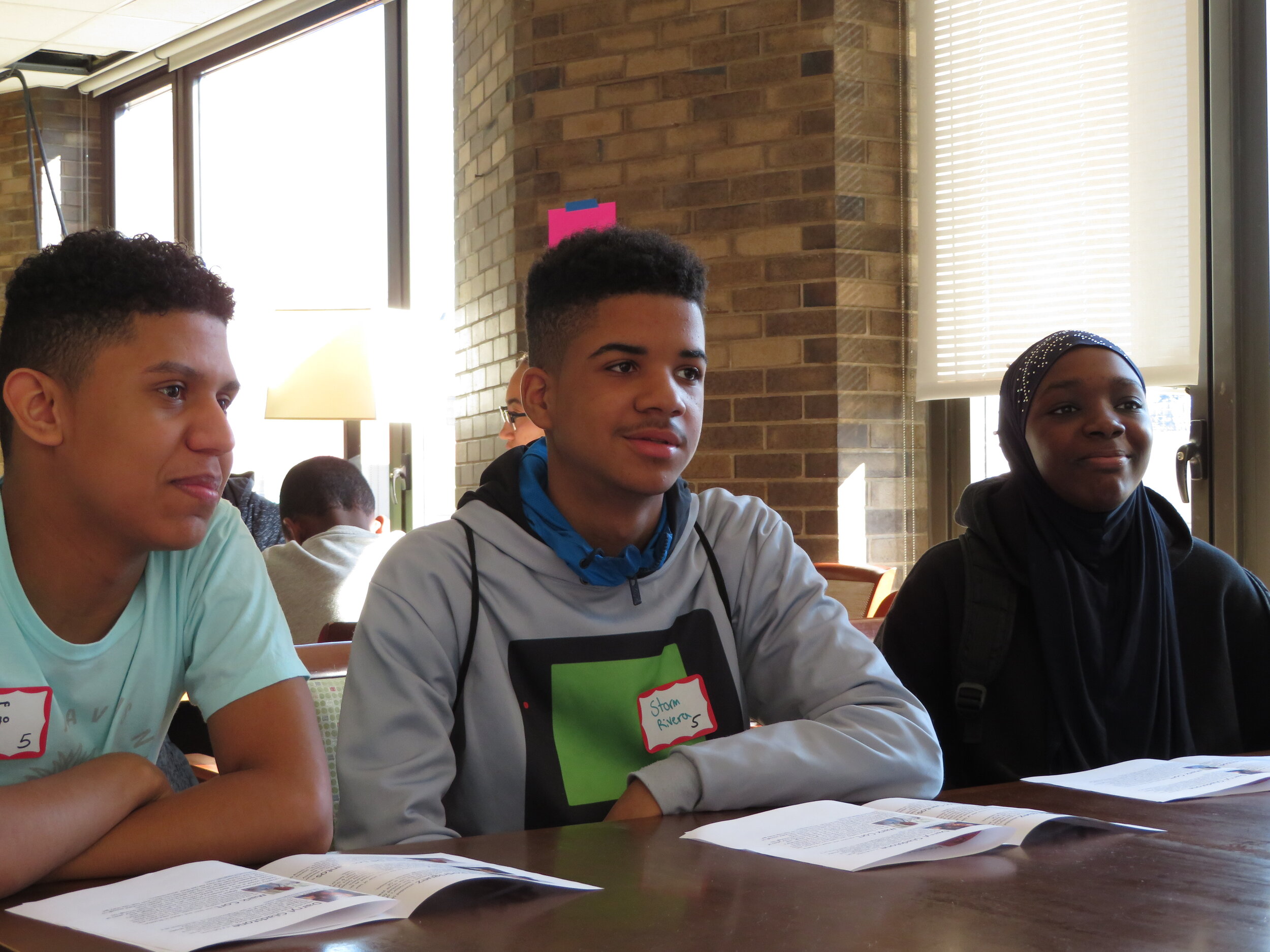
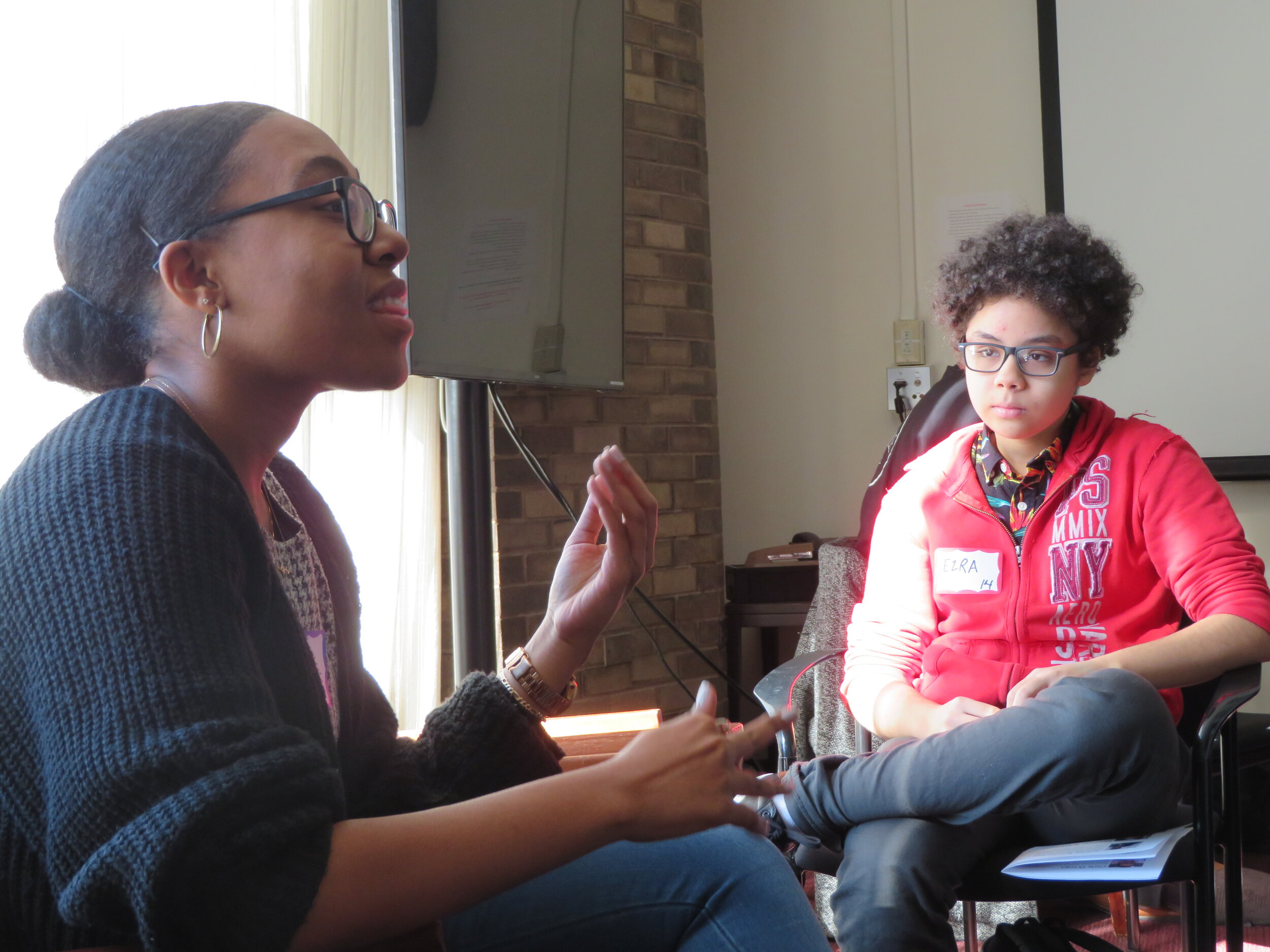
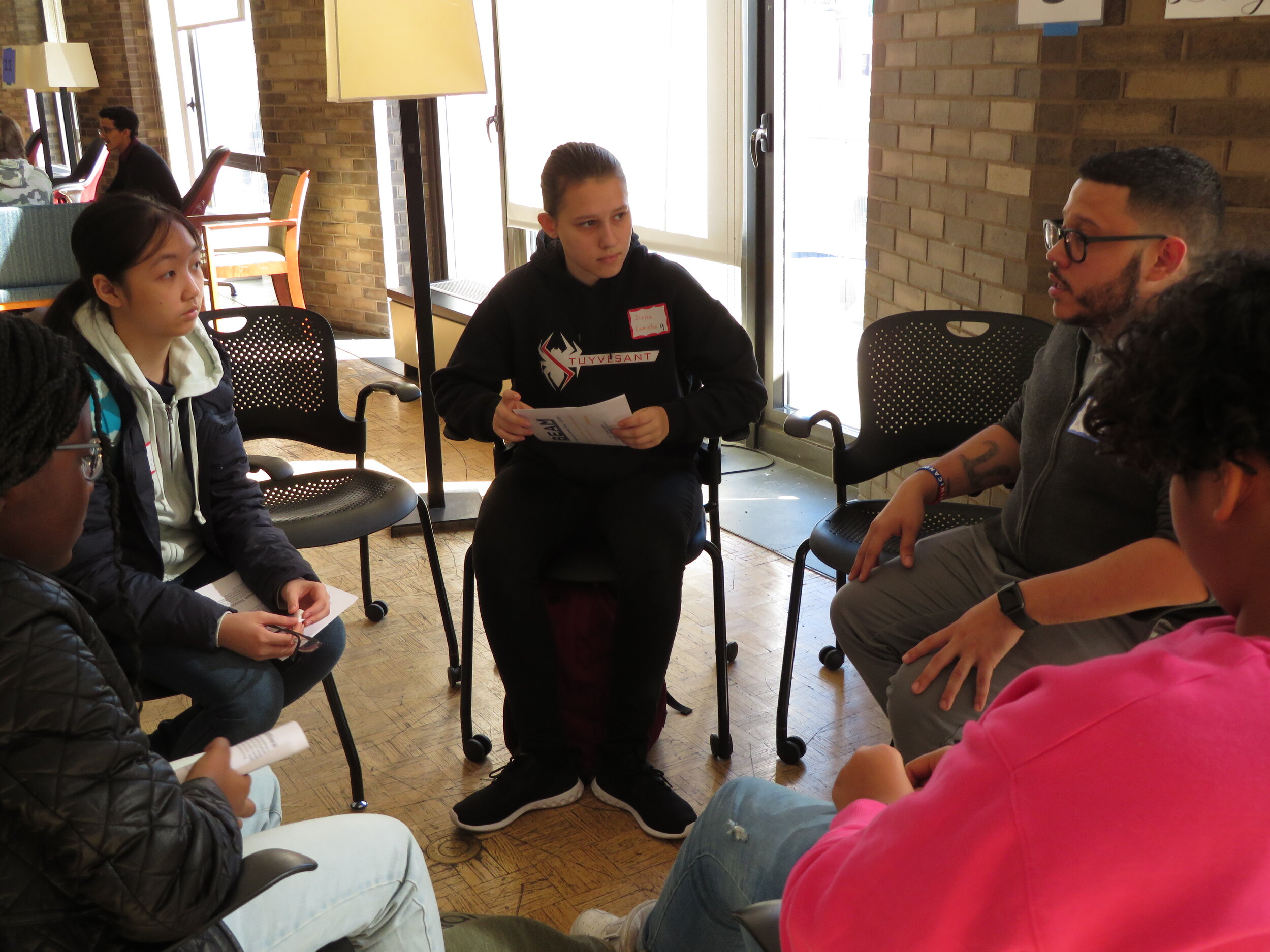
BEAM's Empowerment Groups
Recently, an article featuring Dr. Edray Goins, a Black mathematician and past speaker at BEAM, gave a glimpse into what it can feel like to be “the only one”. His perspective is a compelling reminder that while STEM careers can be rewarding and exciting, for students coming from historically marginalized communities, the world of STEM can also be incredibly lonely. When you look around a math class and find you are the only person of color or the only woman, it can be a demoralizing experience. STEM spaces are often dominated by people who either accidentally or overtly send the message that underrepresented minorities don’t belong.
Because of the social and emotional dynamics that come with pursuing STEM as an underrepresented minority, STEM preparedness for our students means more than academics. Beyond foundational math and science skills, students need opportunities to grow in their confidence and self-determination needed to excel in a social environment that can be hostile. Ayinde, our College Support Coordinator, and Sylvia, our High School Programs Social Worker, are tackling this aspect of STEM preparedness through a new BEAM initiative: empowerment groups.
“Empowerment from within is something they have to keep moving at. And I think that is where it intersects with STEM. ”
Sylvia leads the Young Women’s Empowerment Group while Ayinde organizes the Young Men’s Empowerment Group. Sylvia and Ayinde share their thoughts on this special project, why they launched it, and what they have learned so far.
What is an empowerment group?
Ayinde: So I think for me, the core of it is, identifying your own viewpoints and your thoughts on yourself and where you stand in society at large. Because I think, especially at the time around high school (college too), there are so many factors that go into how you see yourself, and so many of those come from outside sources: friends, family, media. The point of an empowerment group is to center that, so that the primary source is internal, the primary source is coming from you.
Sylvia: For the women’s empowerment group, that [title] is word for word what we are trying to do; we are trying to empower women. I look back on myself in high school and I think if I had had a support group like that I would have been more confident. Girls are raised to be careful, and boys are raised to take risks. So we have conversations about this within group, and the goal is for them to feel empowered to do anything that they want to do regardless of gender. But also it is a safe space. So I think it is a very therapeutic space. But also a space for them to feel empowered to reach their goals, and reach their potential. I want them to get to a point where they want to accomplish goals not because they are perfect but because they are brave and want to do these things for themselves.
Why empowerment groups? How did you get this idea?
Sylvia: As the social worker in the office, and at first as the only not mathematical person in the office, it felt like BEAM was missing something and there was something in my toolbox that I could add. And so I was helping a student with a summer program application, and I really encouraged her and kinda pushed her. She got in and she said it was great, but privately she told me about a actually really traumatic experience that happened during the program. It got me thinking about what we do here at BEAM and how we sometimes put them [students] into places where they are the only one (race or gender), and it made me think about how we can support our students more holistically. And so I sat down with Ayinde.
Ayinde: Having experience with another non-profit (as an Oliver scholar), and part of my experience then was them preparing us to be in spaces where you are going to feel like an outsider or an outcast. So having had that experience coming to BEAM, I knew we needed to move in the direction of grafting conversations like that. But it wasn't until my conversation with Sylvia that I started to see how we can go about having those conversations. The other part was I went to an all boys middle school. So I have had thoughts about boys and how they perceive their ideas about manhood and how those ideas grow, and I wanted to have space to talk about grafting one's identity for a very long time.
“I think both directly and indirectly they [empowerment groups] allow us to make sure our students know the importance of how they view themselves. ”
BEAM is about math, right, and STEM access? Where do the empowerment groups fit into that mission?
Ayinde: One of the biggest things that, I think, is getting spoken about more these days, but still not enough in my opinion, is the aspect of what it means to belong and feel like you are a part of a specific career path: to feel as though you are a engineer or a mathematician or a scientist. And lot of things go into that. A lot of things affect what students believe about themselves. I think both directly and indirectly they [empowerment groups] allow us to make sure our students know the importance of how they view themselves. Specifically, because the majority of the students in the men's group are seniors, we talk a good bit about how they view themselves and when that view comes in conflict with how the people around them view them. What I am trying to do is prepare them for when they go to college, and they are away from their friends and family, and they are in that 100 student math class, maybe with only 5 or 6 people who look like them, and maybe feel like they are the only ones struggling, when that moment comes, that is not a reflection that they don't belong in that space.
Sylvia: I agree with a lot of what Ayinde is saying, I think with women there is the other layer, of the fact that women are not represented in STEM. Also I think that currently all of the women in the women’s group are women of color, which adds another layer. So making sure that they feel confident in themselves that they can succeed in STEM if that is what they want to do. Or, if it is not, that they still have that confidence in themselves and allowing them to feel comfortable in spaces that are predominantly male dominated. Little things like when they have a disagreement and they want to share it. Or if all of the people raising their hands in the class are male, that they can feel comfortable raising their hand. Empowerment from within is something they have to keep moving at. And I think that is where it intersects with STEM. Also feeling comfortable asking for help. When you have a space to talk about stuff that you can't talk about at home or school, then it leaves more space to get more out of school. They can unburden themselves, and concentrate more on school and applications and other stuff.
How has hosting empowerment groups changed you?
Ayinde: I always wanted to create a space for young men to talk about what it means to be young men and what that means for them specifically, not what they have observed, what they've been told, but internally. But beyond really being able to do that in a concrete way, it has been seeing what that impact means: what it is now. To see a group of young men who are open in various different ways. These weren't boys who I was ever worried about them expressing themselves or having emotions, but how much that has evolved in terms of how they talk about things with each other, and how much they talk about their issues, and what they are going through, and how much they trust each other with that and to some extent me as well, to share these kinds of things with each other. The idea of brotherhood and what that looks like in its most ideal form has been something that I have thought about for quite some time and it has really been a dream to kinda see that form in this group.
BEAM staff, Sylvia and Elyse, with the Young Women’s Empowerment group on a field trip to see Reshma Saujani, founder of Girls Who Code, in conversation with Stephanie Ruhle from MSNBC.
Sylvia: I think I finally have found my niche at BEAM. I have always helped with this and that, and was very passionate about helping co-direct a BEAM site. But in this I think I have found my baby. Because I can go up to a funder or a donor and say that this is what I am doing and why it is important. I think being able to impact the girls the way I do is really great and really powerful, knowing that they know they have a mentor in me and that they look up to me.
Can you tell me about a moment that was particularly beautiful or meaningful that happened because of these groups?
Sylvia: There was one silly moment, they girls had left and I overheard them saying “oh, this is actually really cool!” I have gotten text messages from students saying thank you. There was a particular group that got pretty emotional. The girls were digging deep into feelings that they maybe hadn't been able to to share in other spaces. It was really good to see them being strong and willing to share these feelings. I think every group has its own special moment, but that in particular was really special.
Ayinde: Similarly, there are a lot of moments. One that I particularly think about was a little bit early on. In the beginning the men's group didn't have a lot of people who were consistently coming. One week, it was just myself and two students and I was worried that everybody felt like they didn't really feel the purpose of coming. That was the first time that one of the students asked a question, saying: can we talk about this thing? It led to a really beautiful conversation about identity, and at the end of it the student told me that he was really happy and it meant a lot to him that he was able to talk about it. So even though it was a small amount of people at that time, it was important and it mattered.
Ayinde works with Teo (BEAM ‘14), Jahleel (BEAM ‘15), and Zyan (BEAM ‘15) at the Young Men’s Empowerment Group. Photo taken by Peter Dressel.
BEAM Students Make Summer Plans
BEAM students and families gather for the summer program presentation.
After spending two summers at BEAM, what do BEAM students do next? They might want a summer break, staying home or traveling with their family for vacation. But many students want another productive thing to do with their time! Each winter, we encourage our alumni to apply for summer programs to help broaden their knowledge, explore enriching learning experiences, and spend their break in a meaningful way. This is especially part of BEAM’s mission to prepare under-served students for future STEM careers. We aim to support students by helping them to applying to various STEM orientated summer programs, and our unscientific surveys of STEM professionals prove what the BEAM audience already knows: summer preparation in middle school and high school opens the door to STEM success in college and beyond.
BEAM alumni Teo and Jennora share their experience from summer programs they have attended.
On January 26th, BEAM students gathered at NYU’s Courant Institute for the annual Summer Program Information Session. This event’s main focus was to start the process of selecting summer programs and preparing summer applications. The information session began with a presentation highlighting the importance of applying to summer programs and how to go about the application process. We also had a panel of four BEAM alumni who answered questions and discussed their experience in different types of summer programs. After hearing about the different options, students broke out into groups by grade in order to review a list of their personalized summer program recommendations. As the beginning of the year goes by, we encourage our students to start their applications as soon as possible in order to give themselves the best opportunities. Overall, the information session pushed students to start thinking about their pathways towards STEM careers in addition to giving students the chance to hang out with the BEAM family.
BEAM students: it’s not too late to apply to amazing opportunities for summer 2019! Contact your year leader to learn more.
BEAM Alums Do Amazing Things: Summer Vacation Edition
BEAM starts with the summer programs we run (BEAM 6 and BEAM 7), but then encourages our students to apply to summer programs, internships, and jobs that keep their academic growth going. Here's what a few of our alums did during summer 2018!
Malachi, Mathworks Honors Summer Math Camp at Texas State University
Malachi holds the BEAM alumni record for most consecutive summers spent at a math program: six! After a summer at BEAM 7 (2013), Malachi attended MathPath (2014) and then the Mathworks Honors Summer Math Camp at Texas State University (2015-2017), which he returned to as a staff member this summer (2018).
Meet Malachi
Malachi is a first-year student at SUNY Binghmaton where he plans to major in actuarial science.
What did you do this summer?
I went back to Mathworks for a very different experience. Some of it was the same, like the camp environment. Some friends I remembered (but there are fewer of us in my grade each year). Above all, I had more responsibility. I had to grade papers, reading student proofs. We had to focus on where the information was both efficient and sufficient. We tried to follow a script, but each counselor has a different level for what constitutes a good enough proof. We were constantly trying to make sure we weren’t too lenient or too tough. With three years of writing proofs, you know what a proof is. So I told my students to focus on clarity and correctness. You can be clear about the wrong point. Or you can be correct but no one can understand your work. But if you meet those two requirements, the proof is right. That’s how I graded.
A big part of my job was being welcoming to the young kids. I worked to bring my social skills to the job because the students were so academic and I just wanted to make them feel comfortable, feel happy to be there. It was nice to be responsible for the well-being of other people. I chose to be a first year counselor because I knew I wanted to be welcoming to new students. I supported a mix of 9th-11th graders, but spent the most time with 9th graders. I even had one student who had finished 8th grade but had already finished Calculus!
In my spare time, I also took an optional course, where topology was the course being offered by a professor on campus for the benefit of the counselors. So I was studying and working.
Vielka, Malachi, and Crisleidy at their graduation from Brooklyn Tech. Vielka and Crisleidy spent summer 2018 working for BEAM as Junior Counselors at BEAM 6 NYC.
What was the application process like? Did BEAM prepare you in any way for that application?
Technically you have to apply. But I knew they had wanted me to return; they liked the skills I brought and the diversity (both ethnic and geographic). They didn’t ask me to complete the entire application process.
What was the highlight of your summer experience?
Being able to have the experience of building trust with new students, piquing their interest. I love having an impact on others. Some kids, I know I made their experience better. I did that. I’d already done the trips, the program itself, so the main focus for me was being the favorite counselor for some students.
What was something unexpected about your summer experience?
It was exactly what I expected. There were times when the workload was overwhelming, especially when my topology class had to be balanced against the grading. So I learned to balance my work (which I have always done) but also the work of everyone else in my group. But I knew that responsibility was coming.
Why did you keep going back to Mathworks?
This year, the money was a big factor! But at this point, it’s comfortable. It’s an environment I want to be in. Folks have similar interests. I know I will meet people who I like to be around, I like to converse with. I want to have that impact that other counselors had on me in the past. Each year, there are people I want to see again, math I can learn that I’m interested in, research that I want to get to do. It’s a family bond, a family atmosphere, a bond I have. I love that BEAM is 3 weeks, but Texas is 6 weeks. Just imagine how much stronger the bond is!
Malachi attends MathPath, 2014.
Zeñia and Teo, Cooper Union Summer STEM
Both Zeñia and Teo were accepted into this very competitive program! We asked them each about their experiences.
Meet Zeñia!
Zeñia is a 12th grader at St. Mark's School, a boarding school in Massachusetts.
What did you do this summer?
I took a racecar engineering design class. The class split up and each group focused on a different component of a racecar. My group worked on the “impact attenuator”, which is something that purposely deforms to protect the driver in case of impact. We wanted to find the best shape and material for an “ideal crash.” We wanted to work with carbon fiber rather than aluminum which is used currently. Our job was to figure out what the ideal attenuator would be for a racecar crash. We used a testing rig (put weights and crush it) to test out prototypes. We built a lot of prototypes. We chose which was best and modified it accordingly.
The program lasted for 6 weeks. We did presentations every week. Presenting was a great skill I can take back for my own future.
What was the application process like? Did BEAM prepare you in any way for that application?
They had you write an essay about why you were interested in STEM and spending the summer doing something in this field. Sarah at BEAM helped edit my essay.
Oscilloscope graph.
What was the highlight of your summer experience?
Understanding the oscilloscope because no one on our team knew what it was. We were able to understand it, graph data and analyze the date. After this we made the prototype and then “crushed it.” [See below for what that looked like!]
What was something unexpected about your summer experience?
I’ve been used to going to summer programs that are sleepaway. The idea of commuting to a college campus and it took me some time to adjust. I had to go home at the end of the day. I expected to get tired and annoyed, but I didn’t, which was a great realization.
Would you recommend this summer experience to other students? Why or why not?
Yes! Definitely, I would. I knew I was interested in mechanical engineering and knew this experience would be great for me. Even if you don’t know what specifically in engineering you want to do, there were a lot of programs to choose from. The team and faculty were very supportive and helpful. You didn’t need prior knowledge; everyone was willing to teach you. This was helpful in helping me figure out what type of engineering I wanted to do.
Crushing the prototype!
Meet Teo!
Teo is a 12th grader at Millennium High School.
What did you do this summer?
I played Fortnite—just kidding. I did a STEM program at Cooper Union for 6 weeks. I chose the "STEM to STEAM Rube Goldberg Project" because I saw a video about this that BEAM sent out to us when they were telling us about the opportunity at Cooper Union. We were put it to teams where we were tasked with creating a kinetic sculpture which is basically like a “moving art piece” where we had to answer the question “What Does NYC Mean to You?” We created a marble machine that went through all parts of NYC. There were electronic parts. We built parts and 3-D printed components. It was a combination of constructing and engineering.
What was the application process like? Did BEAM prepare you in any way for that application?
They required transcript and an essay asking why I wanted to be a part of the program. BEAM helped because I wrote the essay the day before it was due and Dan really stuck by me through the night and helped me revise my essay. Disclaimer: don’t do this.
Teo shows his kinetic sculpture to other BEAM 11th and 12th graders during a college tour of Cooper Union.
What was the highlight of your summer experience?
Getting engineering experience. I learned to use laser cutting machine, how to 3-D print, and how to do circuitry work. I also used hand saws and electric saws to cut through tough material. I used a lot of tools.
Would you recommend this summer experience to other students? Why or why not?
If you’re in to engineering, yes! It is a good experience. Or if you want to find out more about engineering it might be a good way to determine if it’s for you before you go to college. Now I really want to study engineering because it was fun.
Adrianne, Black Girls Code
Meet Adrianne!
Adrianne is an 11th grader at NEST+m.
What did you do this summer?
I spent the summer with Black Girls Code. Over the course of the program, we first learned how to build websites, and then apps.
What was the application process like? Did BEAM prepare you in any way for that application?
BEAM introduced me and my mom to the program and then my mom signed me up. There wasn’t much of an application!
What was the highlight of your summer experience?
Presenting the final project: my app. What I made was a dog app, and it basically helps you find your lost dog. I had to make a map which is very hard. Very hard!
What was something unexpected about your summer experience?
The sense of community that I built. I didn’t expect to be as close within a 2-week period as I was. It was really intense. We also got to go on some trips too.
Would you recommend this summer experience to other students? Why or why not?
Yes, definitely. Not only does it allow you to know more about computer science in general, but also we went on trips to different companies and you hear about the different companies. Above all, it was a program with like-minded people who want to achieve the same goal as you.
Maria, Lenox Hill Hospital Radiology Internship
Meet Maria!
Maria is a 12th grader at St. Jean Baptiste High School in the Bronx.
What did you do this summer?
I did an internship with Lenox Hill Hospital (where Beyonce gave birth to her first child). I was assigned to the pathology dept (where they do lab work, including bloodwork, surgical specimens, and more). My mentor made sure that I got to rotate through all the different part of Pathology: surgical path, chem path, hematology path for examples. I was introduced to all lab leaders in each department. Also, on Wednesdays, we had enrichment days where everyone in the program got together with the director of the program and we would meet different people in the hospital or do surgical tours. We got to see the inside of an OR (operating room) and I saw two operations from next to the operating table. I saw a mastectomy and breast reconstructions and also an above-the-knee amputation. Through glass, I saw an “angiogram”—to check blood flow in the brain.
In surgical pathology I got to see different specimens that came in. For instance I saw breast tissue that was taken from a mastectomy. I also saw a fetal autopsy on a 15 weeks fetus.
Infectious diseases under the microscope.
In hematology I looked at slides under a microscope. I saw malaria-infected cells and cancer-infected cells. I also saw how they prepped the slides.
I got to meet the doctor who the movie Brain on Fire is about. I was starstruck. Dr. Najjar is a very famous doctor who made a groundbreaking discovery in medicine.
What was the application process like? Did BEAM prepare you in any way for that application?
There is a partnership through my high school; my guidance counselor approached me and told me to apply. I had to complete an application, write an essay, and go through an interview. I also had to provide info about my grades. I was the first interviewee and I was very scared. They asked me about stuff I wrote in my essay, such as how the program would benefit me and my interests in medicine. In the interview, I talked about BEAM as a program that has guided me.
Yes, BEAM helped me throughout! I had Sylvia read my essay a bunch of times.
What was the highlight of your summer experience?
Networking. What 17-year-old can say they have connections with doctors at a hospital? It’s also something substantial to put in my college application.
Watching the mastectomy was another highlight. It was a 9-hour surgery, I was there only for four and it was exhausting for me. The surgeon was also teaching his students. On top of leading the surgery, he was also teaching, which is important and definitely something that I want in my future when I go to med school.
Would you recommend this summer experience to other students? Why or why not?
I would say yes, but only if you’re considering a profession in health and medicine because it definitely makes or breaks it. You either love it or hate it. You see the hospital as it is—it’s not like watching Grey’s Anatomy.
Isabella, NYU Tandon School of Engineering's ARISE
Isabella presents her passive dynamic walker at the end of the summer.
Meet Isabella!
Isabella is an 11th grade at Manhattan Center for Science and Mathematics.
What did you do this summer?
I was in a research placement at a mechanical engineering lab at NYU’s polytechnic campus in downtown Brooklyn.
What was the application process like? Did BEAM prepare you in any way for that application?
It was all kind of a blur because I was doing it way back in January. I didn’t expect to get in, because I really struggle with writing. The essay process was rough and it took a lot of my time. Each week, at BEAM Next Saturday classes, we took some time to break down what was required to apply and how to meet necessary deadlines. That really helped me get the application done and get in.
What was the highlight of your summer experience?
Being able to understand complex computer languages that I haven’t before. We learned to use Arduino and Matlab.
What was something unexpected about your summer experience?
It was kind of hard. But other than that I felt prepared for everything.
Would you recommend this summer experience to other students? Why or why not?
Yes, I would recommend it. But I don’t know if their experience would be the same as mine, because there’s different labs in different buildings. You get what feels like a real college experience.
Jennora, Met PALS Internship
Meet Jennora!
Jennora is an 11th grader at Bard High School Early College.
What did you do this summer?
The Met PALS program (Metropolitan Hospital Center Preparation for Achievement in the Life Sciences) is prep for people who want to go into medical field. You get a chance to figure out what exactly you want to do in the medical field. You’re walking in the hospital, with your coat on, watching what’s going on and talking to the staff. There’s also lectures about how you become different types of medical professional.
What was the application process like? Did BEAM prepare you in any way for that application?
It was not that rigorous! I was volunteering at the hospital already and the coordinator told me that Met PALS would be a chance to do more intellectual tasks. So then I filled out some forms and there was an interview, but I didn’t have to write an essay.
BEAM has helped me over the years get into programs: how to write essays, answer questions, do paperwork. Now I can apply for things by myself and I can be independent and I know what to do, but if I do need BEAM for an application or a recommendation letter, I know you’re always there. That support is so helpful.
In the past, BEAM has helped Jennora with her successful applications to GOALS for Girls and Center for Excellence in Youth Education (CEYE) High School Summer Program, where she studied zebrafish toxicology.
What was the highlight of your summer experience?
So much! Surgery was amazing; I would have never have expected being able to watch a real surgery in the Operating Room. But there was so much more to the program. I loved the overall experience, being by yourself, walking around the hospital, being independent, being surrounded by adults who know what they’re doing. It felt mature and independence. I grew so much as a person.
What was something unexpected about your summer experience?
Surgery! Didn’t know I would see that. I got to change into scrubs and be on the inside. In some departments, you would talk to patients and even hear private information. It was crazy to see a biopsy in front of my eyes!
Would you recommend this summer experience to other students? Why or why not?
Of course!! There were only 10 of us in the cohort. Lots of freedom. Plus, I’m curious about the medical filed and I really got an inside look. There are so few opportunities at my age to understand so many things about the medical field. I’d never heard of residency before doing this! I saw radiology, PT, OT, internal medicine, NICU. I explored the whole hospital.
Porter, Center for Talented Youth
Meet Porter!
Porter is a 9th grader at the High School of Telecommunication Arts and Technology in Brooklyn.
What did you do this summer?
I played a lot of video games... I also went to the Center for Talented Youth (CTY) and took an engineering class, which was basically an intro to the engineering process.
What was the application process like? Did BEAM prepare you in any way for that application?
The application process was not really so stressful. You had to take a test, and then find out if you qualified. Then, you got to select what classes you wanted and which location. BEAM facilitated the test and helped me study for it.
What was the highlight of your summer experience?
Meeting other people interested in the same things as me.
Would you recommend this summer experience to other students? Why or why not?
Yes. It was really fun. It was also really interesting and instructive.
Welcome to BEAM 6 2017
Week 1: Start of Something New
The summer is in full swing, but BEAM is just getting started. So far students have been assorted into one of two sets, either Calderón or Granville, and begun taking classes in Logical Reasoning, Math Fundamentals, Applied Math, and Math Team Strategies.
Faculty member David assists Justin, Jose, and Conaré during Open Math Time.
Some students are excited about taking their first class on computer programing, while others are asking hard hitting questions about force and relativity in their Space class.
"Give me more challenging problems" -Lilly (Calderón) proudly displaying her decorated binder
Jason, Brianna, Messiah, and Mohammad are enjoying an exciting game of Kickball.
Open Math Time (OMT) gave everyone a chance to work on problem sets in groups or ask for assistance from the Teaching Assistants.
Nicole, Maryam, and Aamirah working during OMT
Last week many students have attempted this week's challenge problem during their OMT. Ten students have already completed the Challenge Problem. Students are discovering they have a lot in common with kids from both sets during their daily and weekly activity times.
BEAM 8th Graders Visit NYC Google Headquarters!
Ever wondered what Google, one of the top multinational technology companies in the world, is like? Our 8th graders got the chance!
This past Friday afternoon, our 8th graders visited the Google NYC headquarters to learn about what working for Google is like. They learned about "Math and Google," Software engineering and Time Complexity Theory! They then took a tour of the building and asked a panel of Googlers some thought-provoking questions.
Software Engineering was presented by Luis. He assists in developing software to help run Google as a company.
With Luis, students learned how to simulate IP networks. They sent each other "human messages" using IP addresses!
"Math at Google" was presented by Paul. He works with Gmail and uses mathematical equations to make email sorting easier for users!
"Time Complexity Theory: How Fast can a Computer Solve Problems?" was presented by Kenechi. Kenechi is a software engineer who taught our students how computers use Logarithmic Notation to solve problems.
BEAM students then took a tour of the Google building. They learned the history of the building and the significance of room names (they're all named after NYC landmarks!) They were able to see the game room, which allows Googlers to take a mental break from working in order to help stimulate their brains for more creative ideas. They saw the Google kitchen which allows Googlers to have a well-balanced meal for lunch and provides snacks for when they need them. Google is an awesome place to work at! Employees even travel around in scooters because hallways are so long!
Take a look at these pictures for proof !!
The day at Google ended with a panel discussion. BEAM students asked thought provoking questions to 4 Googlers: Paul Cheong, Justin Venezuela, Molly Alter and Kenechi Ufondu.
Examples of questions were: "What advice would you give to me pursuing a career revolving around my love of math?" "What kind of mathematics is used at Google?" "How does it feel like to be apart of such a large company?" "Is this your dream job?" The panelists were amazing and honest. They provided our students with great insight on what it is like to work for Google.
We hope to see some of our alumni working at Google in the next 10 to 20 years!




